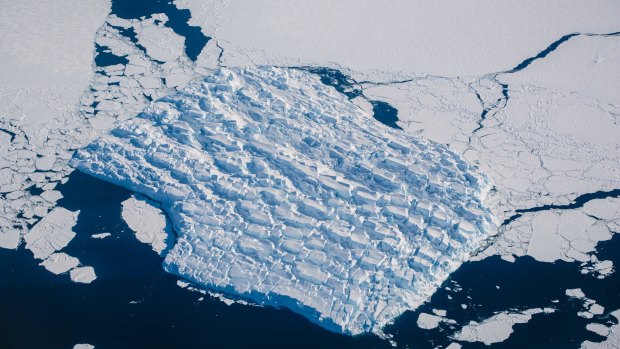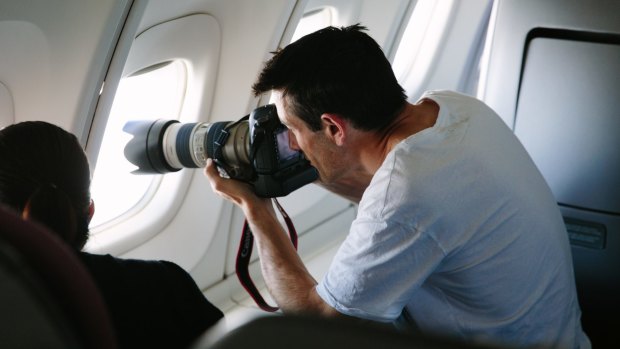This was published 7 years ago
Qantas chartered flight to Antarctica: What it's like to fly over the coldest continent on earth
By Sue Bennett
The departure board at Sydney's terminal 3 reads Mystery Flight with a boarding time of 7am.
Passengers on QF2904 take a 747-400 jumbo jet that flies, non-stop, for 13 hours and in a circle. Passports are not required. The journey takes them to the most remote place on Earth; to the highest, driest, windiest, coldest continent on Earth. To a place twice the size of Australia, yet home to just a smattering of people. Antarctica.
And the excitement is palpable. At the departure gate, people line up to be photographed with a man-sized penguin mascot that waves a lot. One elderly man is kitted out in a wool hat with ear muffs (and it's a sweltering February day outdoors). Children, many accompanied by generous grandparents, lift their eyes from devices to take in the scene.

Flying over Antarctica in a Qantas 747, a 13-hour round trip from Sydney.
No one seems to doubt this is special. Very few people get to Antarctica. Australia's Antarctica Flights is the only company in the world to do sightseeing flyovers. In the 22 years since company founder Phil Asker began the service, about 40,000 people have participated. It's an elite club.
As with many long flights, it's best to suspend thoughts about times of day. By 8.45am, the drinks trolley is doing the rounds with gin and tonics in high demand (must be the ice) and lunch follows soon after.
Three hours later, there's a ripple of excitement through the cabin as the first float ice becomes visible on the watery blue expanse below. People squash noses against windows as the hunks of brilliant white, irregular-shaped ice become more populous. Antarctic flight veteran Captain Cameron Hartman brings his craft down from 10,000 feet to about 2000 feet for improved visibility. The icebergs get larger and their giant surface ridges clearer.

Flying over Antarctica.
Binoculars and cameras work overtime as the giant aircraft does a figure eight to maximise passengers' viewing. At one point, the ocean looks inky black beneath the cloudless blue sky and piercing sun with the icebergs resembling tankers lining up to enter a port. Then the plane turns and there's the coastline: A razor-sharp white line stretching out to the distance. Blue on one side, intense white on the other.
We've reached the Antarctic mainland and this is the moment so many on board have dreamed about. Like the father and his three middle-aged sons from Idaho and Massachusetts in the US, who flew to Sydney with the sole purpose of taking the flight. Dad is a retired geologist and reaching Antarctica is a lifelong ambition. "We've still not worked out which of us is going to pay," quips one son with a big smile.
Or the Maroubra man whose kids gave him the trip for Christmas and the charismatic 93-year-old Bondi woman, travelling with her daughter-in-law.
We cross over land close to the French-operated Dumont D'Urville research station. Its buildings, snow-free airstrip and visiting supply ship are clearly visible but none of the emperor penguin colonies scientists study from here. Our on-board, oversized penguin mascot is the closest we get to anything resembling wildlife throughout the trip; even if they were observable from this height, the tribes of Happy Feet are off and away at feeding grounds in this, the Antarctic summer.
For the next four hours, we fly along and over the polar white wilderness. Sunglasses optional but, at times, a good idea. Initially, hugging the coastline and later, into the mountainous inland zone.
At 1.50pm, there's a seat change for some passengers; the company has window access down to a fine art. The aircraft is a regular 747 but, for this chartered flight, it's divided into seven classes from Ice, which uses the plane's 12 first-class seats, to economy centre. From the moment the flight levels off after leaving Sydney, passengers are immersed in Antarctica. There are documentaries and on-board lecturers who commentate and walk through the cabins answering individuals' questions.
After circling Dumont D'Urville, we fly south west and, in the words of Captain Hartman, "hit paydirt". There beneath us, and clearly visible, is Cape Denison. From this height, it's a collection of grey-black rocky slabs surrounded by snow cliffs and ice-littered ocean. Magnified on a camera, Mawson's Hut is in view and it's a thrilling moment.
Made all the more so by the on-board presence of Di Patterson, who led the Mawson Research Station for 13 months, including winter, and has travelled hundreds of kilometres across Antarctica. In 2002, she lived in a tent for two months as part of a team removing 30 tonnes of ice, by chainsaw, from inside explorer Douglas Mawson's historic buildings. In total, she's lived the equivalent of three years on this inhospitable continent. Frostbite to the nose her only injury, she nonchalantly tells passengers: "It's the wind chill factor that makes it such a cold place to live."
Glaciologist Ian Allison took his first of 25 expeditions to Antarctica in 1969. You get the impression this expert in snow, ice and climate thinks today's polar workers have it rather easy: "Now, it's so mechanical ... we even have 'safety' people. Back then, you had to do everything," he tells us. We learn so many fascinating facts about ice from Allison that I'll never look at a cube in quite the same way again. No really. From sea ice to pack ice, fast ice to float ice, moving ice to shelf ice, I find it all quite compelling.
My fascination is only heightened when a giant iceberg, breaking off from the mainland plateau, is clearly seen below.
And then the visibility goes and we head inland, assured of clear skies to come by Captain Hartman. As we traverse Oates Land, huge, snow-covered mountain peaks pierce the cloud cover. Sometimes, the view is full of rocky ridges stretching in the distance; at other times, the sky is clear and hectares of blinding white snow hug a single mountain. Nearing Mount Melbourne (2733 metres), we do a final figure eight over the white wonderland before turning south and flying between Mount Sabine (3720 metres) and Mount Minto (4163 metres), where we do two final, wide circles and everyone can bid goodbye to an extraordinary place.
There's a celebratory mood on board then, back over ocean and heading home, the Qantas crew serves drinks and dinner. Like lunch served earlier in the day, it's a regular Neil Perry menu with choices including prawn, leek and potato pot pie with tomato relish and braised Korean-style short rib with rice. But it's not every day your menu card is labelled Australia to Antarctic.
Our penguin mascot comes calling and a woman produces a picture frame holding the pouch in which Antarctic explorer Ernest Shackleton carried his Bible. She bought it at auction. "I'm more of a Shackleton person myself," chips in another passenger. "I have a bit of Shackletonia at home." I've entered an Ice Age enthusiasts club I never knew existed.
Mawson's Huts Foundation chairman David Jensen's taps into the ardour with an on-board auction and raises more than $5000 for the Hobart-based charity.
I've never wanted to endure the sea crossing to stand on Antarctic ice. To see it from the luxurious warmth of an aircraft is as close as I want to go and if 13 hours' flying sounds a long time, it passes remarkably fast and joyously.
Operator Antarctica Expeditions is relieved Qantas has vowed to continue flying 747s for another three years because its more modern counterparts are not as suited to the task. If a visit to the Frozen Kingdom is on your bucket list, it may be time to look at life in the freezer.
TRIP NOTES
MORE INFORMATION
GETTING THERE
There are four Antarctica Flights this season. They depart Melbourne (December 31 and February 12, 2017), Perth (January 26) and Sydney (February 5). All flights are not the same. The captain of the chartered Qantas 747 has 19 routes from which to choose and the best weather conditions for sightseeing are the deciding factor. The round-trip is 12-13 hours with about four hours over the icy wilderness and iceberg viewing either side. On-board experts, lecturers and in-flight films immerse passengers in the history, exploration, geography, natural wonders and wildlife of the world's coldest, highest and driest continent. Prices start at $1199 for economy to $7999 in Ice (first) class.
SITTING THERE
Most passengers have two boarding passes and, at the halfway point over Antarctica, there's a seat rotation to maximise window viewing. Over four hours, there's plenty of opportunity to walk around and look out from windows and doors and the plane's cameras show the view on video screens.
DINING THERE
Chef Neil Perry's regular Qantas menu is served at lunch and dinner with full bar service.
Sue Bennett travelled courtesy of Antarctica Flights.
See also: Jaw-dropping luxury revamp for Antarctica hotel
See also: A crazy place to go swimming
Sign up for the Traveller Deals newsletter
Get exclusive travel deals delivered straight to your inbox. Sign up now.